Evaluating the Potential of Roof Water Harvesting System for Drinking Water Supplies During Emergencies Under the Impacts of Climate Change: ‘A Case Study of Swat District, Pakistan’
Abstract
1. Introduction
2. Materials and Methods
2.1. Regional Data Collection on the Water Demand
2.1.1. Geographical Profile of the Swat Region
2.1.2. Demographic Information of the Swat Region
2.1.3. Roofing Material and the Runoff Coefficient Value
2.1.4. Catchment Size Details
2.1.5. Water Demand Data
2.2. Climate Models Based Rainfall Data Collection
Rainfall Data Collection from the Climate Models
2.3. Data Analysis Software and Techniques
3. Results and Discussion
3.1. Model for the RWHS in the Swat District
3.1.1. Analysis of the Monthly Average Rainfall
3.1.2. Roof Water Harvesting System Design Calculation
3.2. Water Balance Model
3.3. Projected Drought Periods and Storage Requirements for Roof Water Harvesting Systems
3.4. Performance Evaluation of the Roof Water Harvesting System Under Climate Scenarios
4. Conclusions
Author Contributions
Funding
Institutional Review Board Statement
Informed Consent Statement
Data Availability Statement
Conflicts of Interest
References
- Lee, H.; Calvin, K.; Dasgupta, D.; Krinner, G.; Mukherji, A.; Thorne, P.; Trisos, C.; Romero, J.; Aldunce, P.; Barrett, K. Climate Change 2023: Synthesis Report. Contribution of Working Groups I, II and III to the Sixth Assessment Report of the Intergovernmental Panel on Climate Change; The Australian National University: Canberra, Australia, 2023. [Google Scholar]
- Bolan, S.; Padhye, L.P.; Jasemizad, T.; Govarthanan, M.; Karmegam, N.; Wijesekara, H.; Amarasiri, D.; Hou, D.; Zhou, P.; Biswal, B.K. Impacts of climate change on the fate of contaminants through extreme weather events. Sci. Total Environ. 2023, 909, 168388. [Google Scholar]
- World Economic Forum. What Exactly Is Freshwater and Is There Enough of It? 2022. Available online: https://www.weforum.org/stories/2022/10/water-freshwater-scarcity-uplink/ (accessed on 9 September 2024).
- Zaidi, U.F. WWF Reports Differences Between 2010 and 2022 Floods. The Diplomatic Insight. 2024. Available online: https://thediplomaticinsight.com/wwf-reports-differences-between-2010-and-2022-floods/ (accessed on 9 September 2024).
- Janowiak, J.E.; Xie, P. A Global-Scale Examination of Monsoon-Related Precipitation. J. Clim. 2003, 16, 4121–4133. [Google Scholar] [CrossRef]
- Freni, G.; Liuzzo, L. Effectiveness of rainwater harvesting systems for flood reduction in residential urban areas. Water 2019, 11, 1389. [Google Scholar] [CrossRef]
- Ortiz, S.; de Barros Barreto, P.; Castier, M. Rainwater harvesting for domestic applications: The case of Asunción, Paraguay. Results Eng. 2022, 16, 100638. [Google Scholar]
- Juliana, I.C.; Syahril Badri Kusuma, M.; Cahyono, M.; Kardhana, H.; Martokusumo, W. Rainwater harvesting system implementation for domestic water use: The environment and financial benefits. In ICoSI 2014, Proceedings of the 2nd International Conference on Sustainable Innovation; Springer: Singapore, 2014; pp. 411–421. [Google Scholar]
- Ali, S.; Zhang, S.; Chandio, F.A. Impacts of rainfall change on stormwater control and water saving performance of rainwater harvesting systems. J. Environ. Manag. 2021, 280, 111850. [Google Scholar]
- Kanno, G.G.; Lagiso, Z.A.; Abate, Z.G.; Areba, A.S.; Gondol, B.N.; Temesgen, H.; Van Wyk, R.; Aregu, M.B. Estimation of rainwater harvesting potential for emergency water demand in the era of COVID-19. The case of Dilla town, Southern, Ethiopia. Environ. Chall. 2021, 3, 100077. [Google Scholar]
- Yadav, B.; Patidar, N.; Sharma, A.; Panigrahi, N.; Sharma, R.K.; Loganathan, V.; Krishan, G.; Singh, J.; Kumar, S.; Parker, A. Assessment of traditional rainwater harvesting system in barren lands of a semi-arid region: A case study of Rajasthan (India). J. Hydrol. Reg. Stud. 2022, 42, 101149. [Google Scholar]
- Anchan, S.S.; Prasad, H.S. Feasibility of roof top rainwater harvesting potential-A case study of South Indian University. Clean. Eng. Technol. 2021, 4, 100206. [Google Scholar]
- Mane, S.P.; Shinde, A.S. A Study Changing Pattern of Rain Water Harvesting Management an Ancient to Modern Age in India-Geographical Analysis. Rev. Res. 2014, 3, 1–6. Available online: https://www.researchgate.net/publication/328225425_A_Study_of_Changing_Pattern_of_Rainwater_Harvesting_Management_an_Ancient_to_Modern_Age_in_India_A_Geographical_Analysis (accessed on 10 September 2024).
- History of Rainwater Harvesting. Available online: https://www.renewableenergyhub.co.uk/main/rainwater-harvesting-information/history-of-rainwater-harvesting/ (accessed on 10 September 2024).
- Ahmad, S.; Jia, H.; Ashraf, A.; Yin, D.; Chen, Z.; Xu, C.; Wang, C.; Jia, Q.; Zhang, X.; Israr, M. Water resources and their management in Pakistan: A critical analysis on challenges and implications. Water-Energy Nexus 2023, 6, 137–150. [Google Scholar]
- World Bank Group. Pakistan Country Climate and Development Report; World Bank: Washington, DC, USA, 2022. [Google Scholar]
- Otto, F.E.; Zachariah, M.; Saeed, F.; Siddiqi, A.; Kamil, S.; Mushtaq, H.; Arulalan, T.; AchutaRao, K.; Chaithra, S.T.; Barnes, C.; et al. Climate change likely increased extreme monsoon rainfall, flooding highly vulnerable communities in Pakistan. Environ. Res. Clim. 2023, 2, 025001. [Google Scholar]
- Loo, Y.Y.; Billa, L.; Singh, A. Effect of climate change on seasonal monsoon in Asia and its impact on the variability of monsoon rainfall in Southeast Asia. Geosci. Front. 2015, 6, 817–823. [Google Scholar]
- Nanditha, J.S.; Kushwaha, A.P.; Singh, R.; Malik, I.; Solanki, H.; Chuphal, D.S.; Dangar, S.; Mahto, S.S.; Vegad, U.; Mishra, V. The Pakistan flood of August 2022: Causes and implications. Earth’s Future 2022, 11, e2022EF003230. [Google Scholar]
- Pakistan_Country_Report_2023. Available online: https://unhabitat.org/sites/default/files/2023/06/4._pakistan_country_report_2023_b5_final_compressed.pdf (accessed on 7 October 2024).
- Keely, C.; Reed, H.; Waldman, R. Understanding mortality patterns in complex humanitarian emergencies. In Forced Migration and Mortality; National Academies Press: Washington, DC, USA, 2001. [Google Scholar]
- The Associated Press. After Devastating Floods in Pakistan, Some Have Recovered but Many Are Struggling. Available online: https://apnews.com/article/pakistan-flood-anniversary-ebd91932d0452d47c3b0c4bd2a656f38 (accessed on 7 April 2024).
- UNICEF Pakistan. WASH: Water, Sanitation and Hygiene. Available online: https://www.unicef.org/pakistan/wash-water-sanitation-and-hygiene-0 (accessed on 14 October 2024).
- Moazzam, M.F.U.; Rahman, G.; Munawar, S.; Tariq, A.; Safdar, Q.; Lee, B.-G. Trends of rainfall variability and drought monitoring using standardized precipitation index in a scarcely gauged basin of northern Pakistan. Water 2022, 14, 1132. [Google Scholar] [CrossRef]
- Adnan, M.; Khan, F.; Rehman, N.; Ali, S.; Hassan, S.S.; Dogar, M.M.; Mehmood, S.; Hasson, S. Variability and predictability of summer monsoon rainfall over Pakistan. Asia-Pac. J. Atmos. Sci. 2021, 57, 89–97. [Google Scholar]
- Avalon Cullen, C.; Al Suhili, R. Assessing rainfall variability in Jamaica using CHIRPS: Techniques and measures for persistence, long and short-term trends. Geographies 2023, 3, 375–397. [Google Scholar] [CrossRef]
- UN-Water. Water and Disasters. Available online: https://www.unwater.org/water-facts/water-and-disasters (accessed on 10 July 2024).
- Gwoździej-Mazur, J.; Jadwiszczak, P.; Kaźmierczak, B.; Kózka, K.; Struk-Sokołowska, J.; Wartalska, K.; Wdowikowski, M. The impact of climate change on rainwater harvesting in households in Poland. Appl. Water Sci. 2022, 12, 15. [Google Scholar]
- Yaziz, M.I.; Gunting, H.; Sapari, N.; Ghazali, A. Variations in rainwater quality from roof catchments. Water Res. 1989, 23, 761–765. [Google Scholar]
- Abdulla, F.A.; Al-Shareef, A.W. Roof rainwater harvesting systems for household water supply in Jordan. Desalination 2009, 243, 195–207. [Google Scholar]
- Pakistan Bureau of Statistics. Available online: https://www.pbs.gov.pk (accessed on 9 July 2024).
- UN Habitat. Blue Drop Series on Rainwater Harvesting and Utilisation—Book 3: Project Managers and Implemetation Agency; UN Habitat: Nairobi, Kenya, 2005. [Google Scholar]
- Zaied, R.A. Water use and time analysis in ablution from taps. Appl. Water Sci. 2017, 7, 2329–2336. [Google Scholar]
- Center for Humanitarian Health. Sphere Handbook. 2018. Available online: https://spherestandards.org/handbook-2018/ (accessed on 9 July 2024).
- Home-Water-Use-ig5. Available online: https://water.phila.gov/wp-content/uploads/files/home-water-use-ig5.pdf (accessed on 27 July 2024).
- Ali, Z.; Hamed, M.M.; Muhammad, M.K.I.; Iqbal, Z.; Shahid, S. Performance evaluation of CMIP6 GCMs for the projections of precipitation extremes in Pakistan. Clim. Dyn. 2023, 61, 4717–4732. [Google Scholar]
- Karim, R.; Tan, G.; Ayugi, B.; Babaousmail, H.; Liu, F. Evaluation of historical CMIP6 model simulations of seasonal mean temperature over Pakistan during 1970–2014. Atmosphere 2020, 11, 1005. [Google Scholar] [CrossRef]
- Mendez, M.; Maathuis, B.; Hein-Griggs, D.; Alvarado-Gamboa, L.-F. Performance evaluation of bias correction methods for climate change monthly precipitation projections over Costa Rica. Water 2020, 12, 482. [Google Scholar] [CrossRef]
- Teutschbein, C.; Seibert, J. Bias correction of regional climate model simulations for hydrological climate-change impact studies: Review and evaluation of different methods. J. Hydrol. 2012, 456, 12–29. [Google Scholar]
- Tang, B.; Hu, W.; Duan, A. Assessment of extreme precipitation indices over Indochina and South China in CMIP6 models. J. Clim. 2021, 34, 7507–7524. [Google Scholar]
- Masson-Delmotte, V.; Zhai, P.; Pirani, S.; Connors, C.; Péan, S.; Berger, N.; Caud, Y.; Chen, L.; Goldfarb, M.; Scheel Monteiro, P.M. IPCC, 2021: Summary for Policymakers. In Climate Change 2021: The Physical Science Basis. Contribution of Working Group I to the Sixth Assessment Report of the Intergovernmental Panel on Climate Change; Cambridge University Press: Cambridge, UK, 2021. [Google Scholar]
- Graham, N.E.; Ammann, C.M.; Fleitmann, D.; Cobb, K.M.; Luterbacher, J.; Noone, D.; Pfister, C.; Smerdon, J.E.; von Gunten, L.; Wood, K.; et al. A comparative analysis of the impacts of different greenhouse gas emissions pathways. J. Clim. 2016, 29, 7527–7545. [Google Scholar]
- Allan, R.P.; Soden, B.J. Atmospheric warming and the amplification of precipitation extremes. Science 2008, 321, 1481–1484. [Google Scholar]
- Versini, P.-A.; Pouget, L.; McEnnis, S.; Custodio, E.; Escaler, I. Climate change impact on water resources availability: Case study of the Llobregat River basin (Spain). Hydrol. Sci. J. 2016, 61, 2496–2508. [Google Scholar]
- Ali, S.; Sang, Y.-F. Implementing rainwater harvesting systems as a novel approach for saving water and energy in flat urban areas. Sustain. Cities Soc. 2023, 89, 104304. [Google Scholar]
- Khan, A.; Park, Y.; Park, J.; Kim, R. Assessment of Rainwater Harvesting Facilities Tank Size Based on a Daily Water Balance Model: The Case of Korea. Sustainability 2022, 14, 15556. [Google Scholar] [CrossRef]
- Riefler, R.F. Drought: An economic perspective. In North American Droughts; Routledge: London, UK, 2019; pp. 63–77. [Google Scholar]
- Brunner, M.I.; Slater, L.; Tallaksen, L.M.; Clark, M. Challenges in modeling and predicting floods and droughts: A review. Wiley Interdiscip. Rev. Water 2021, 8, e1520. [Google Scholar]


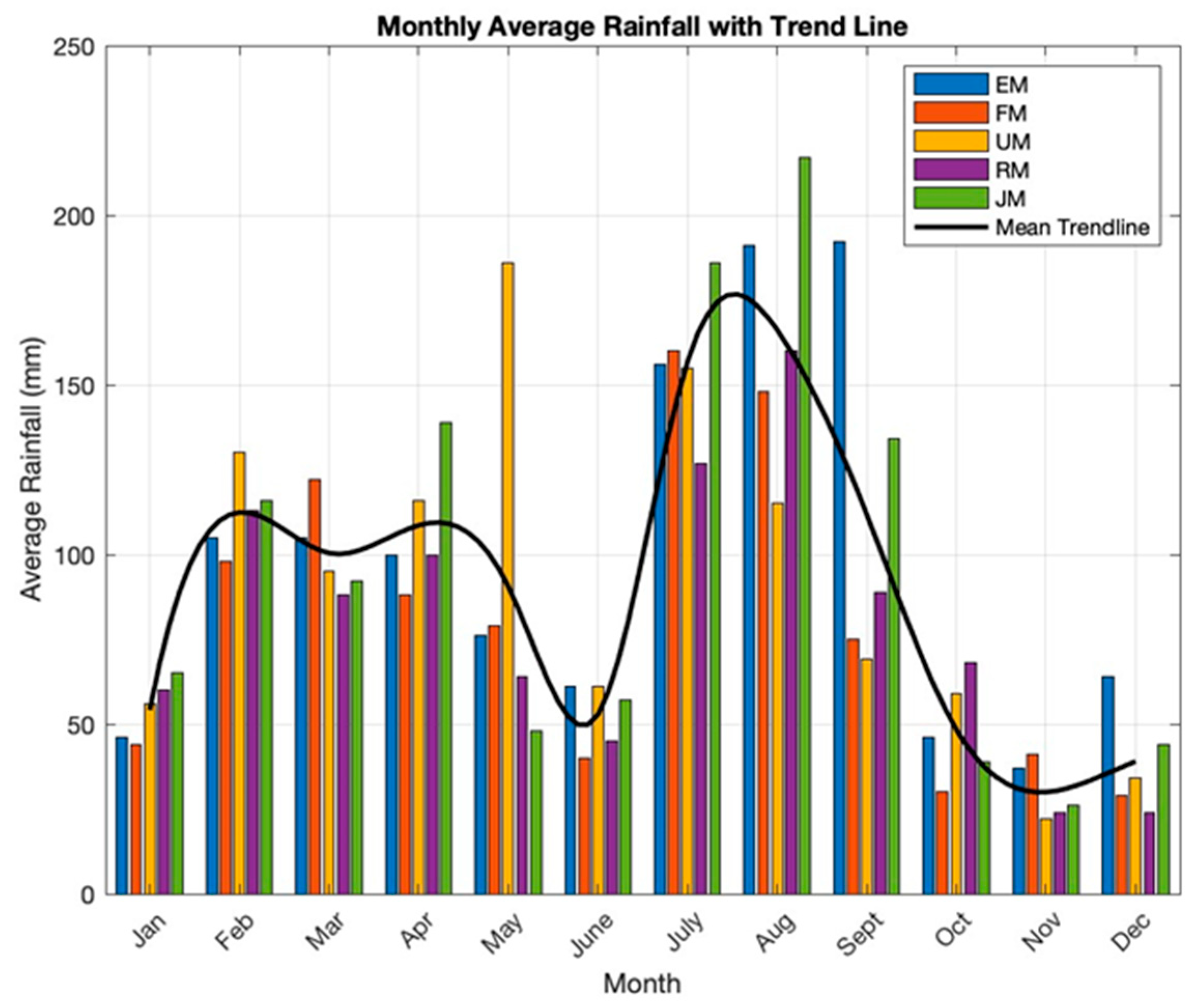
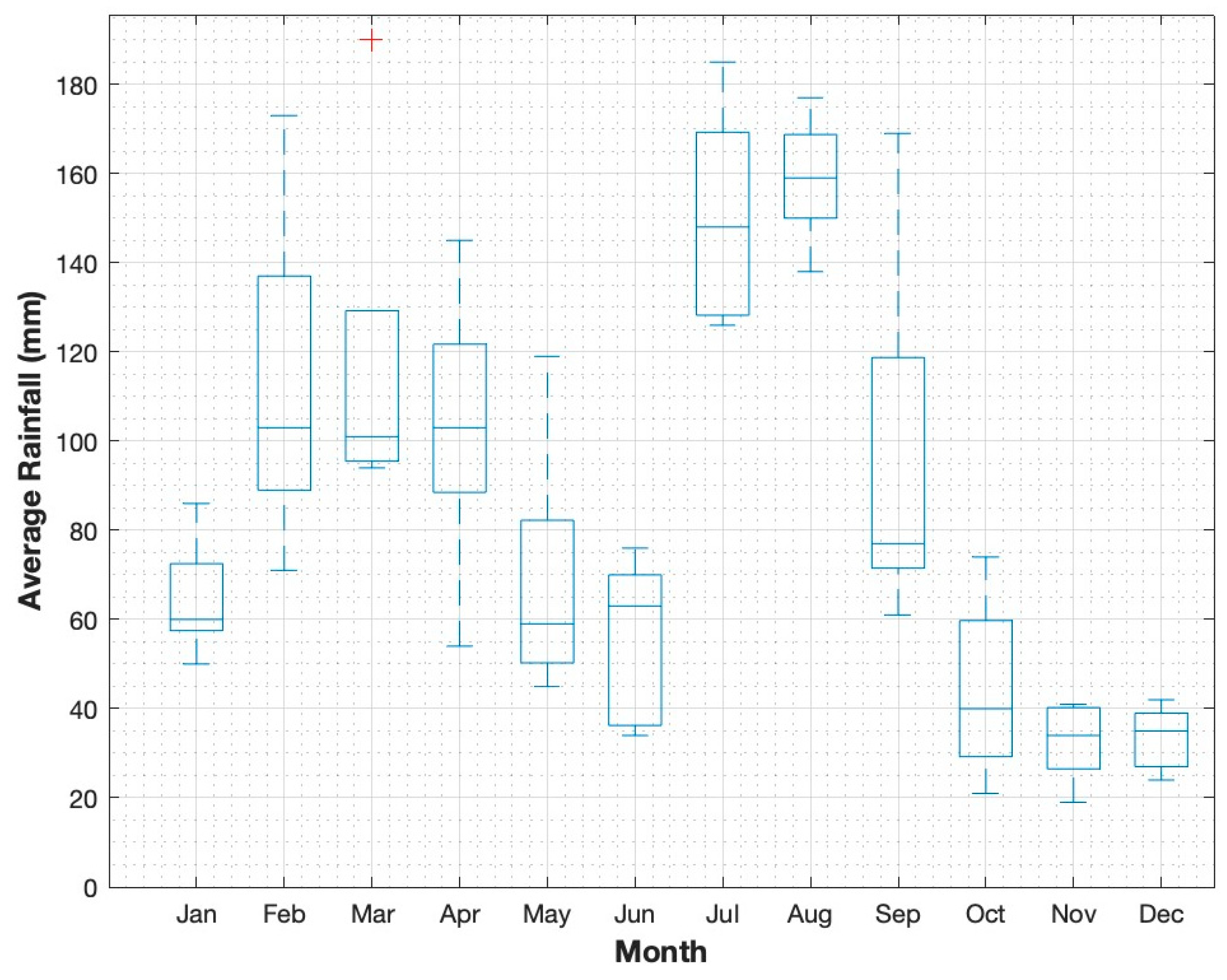
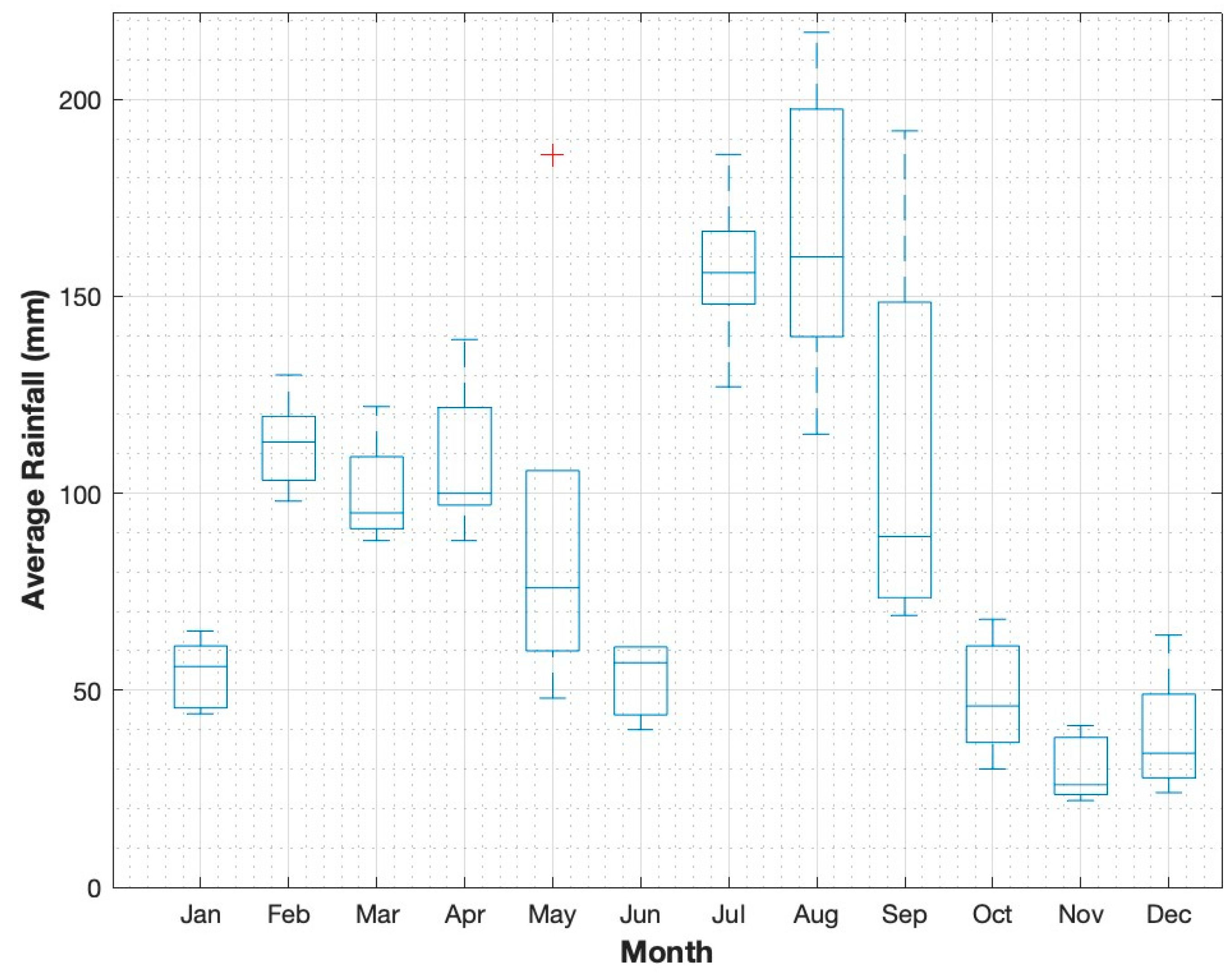
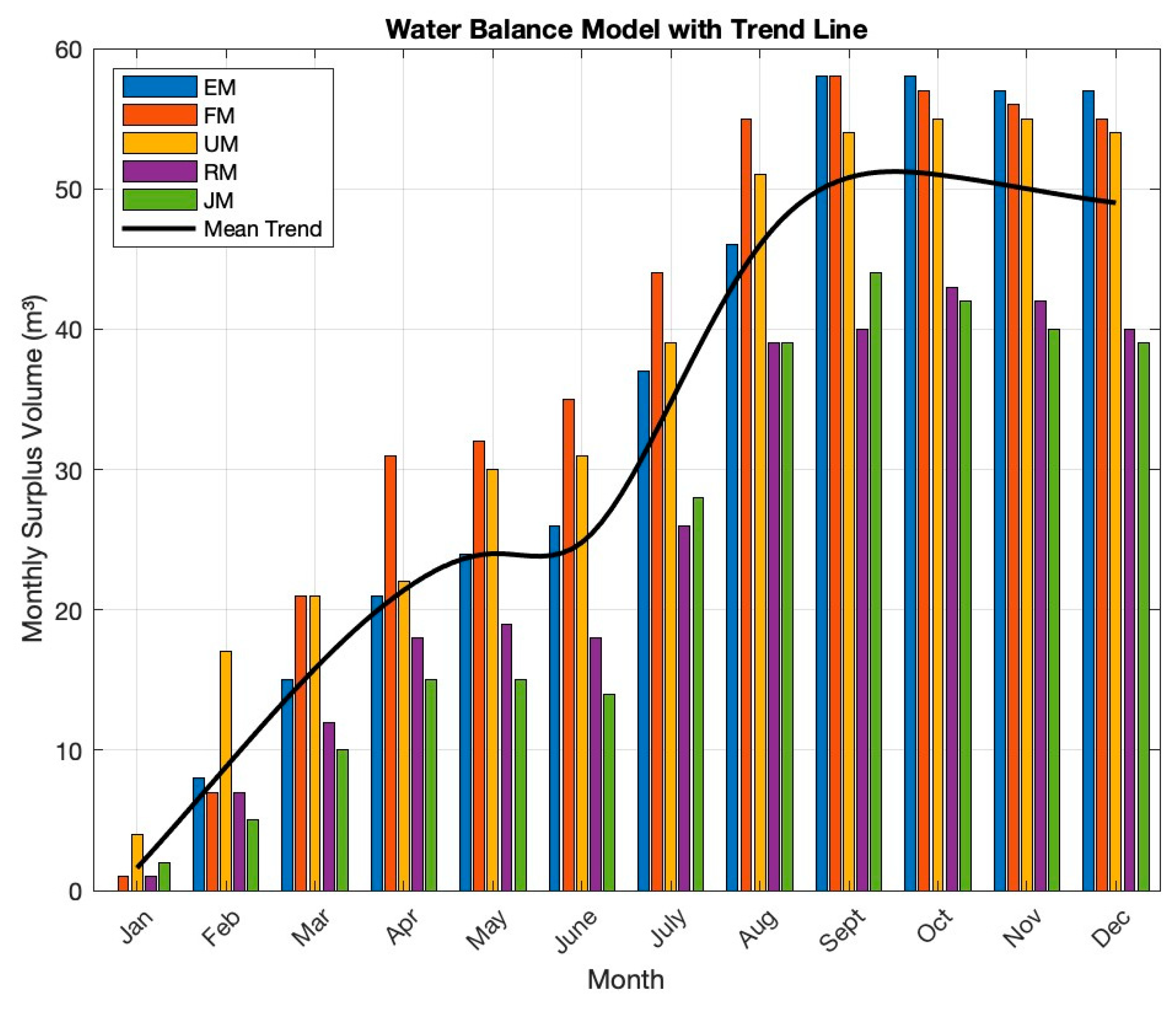
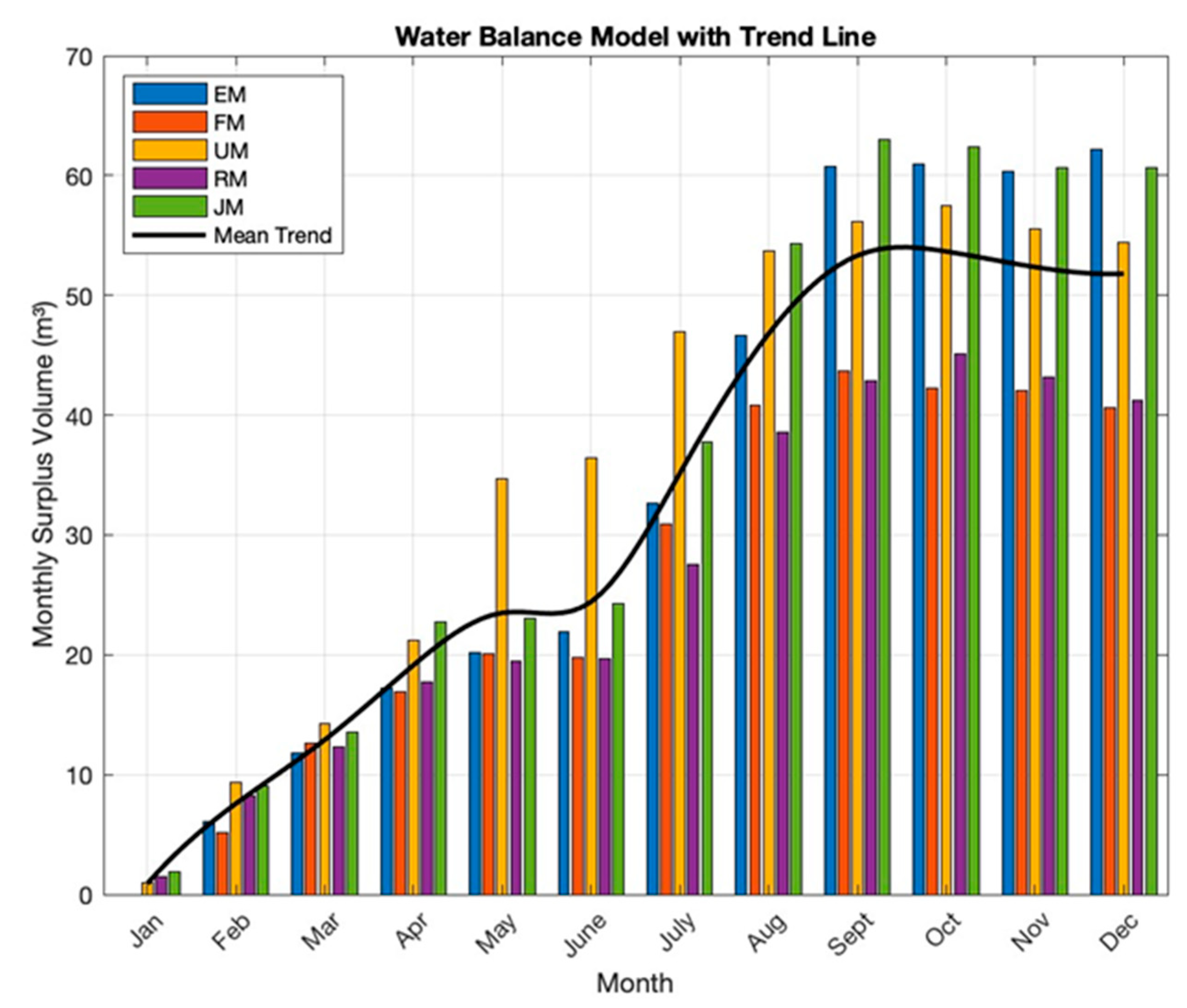
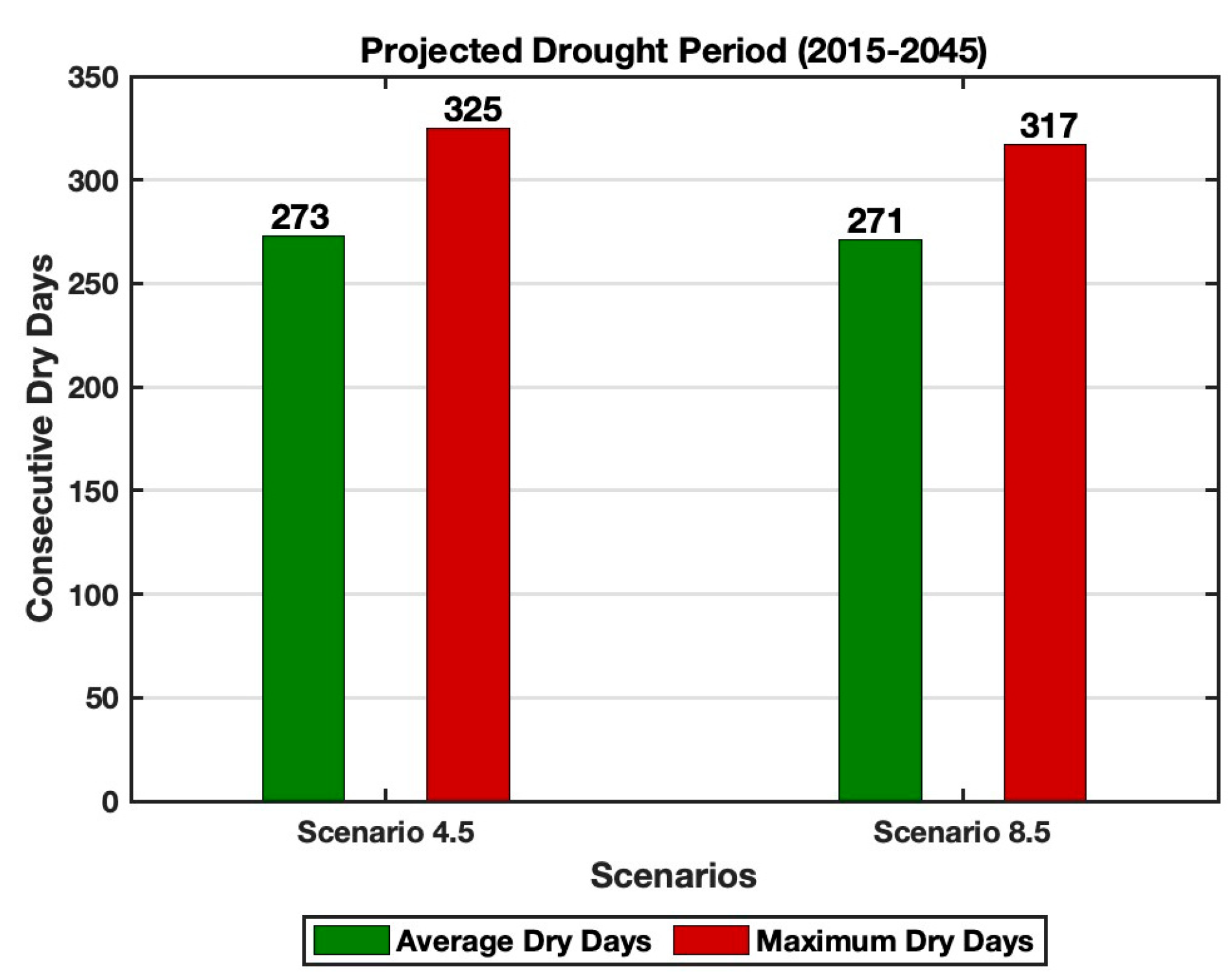
| District | Population (As per 2023 Census) | Average Household Size (Persons/House) | Growth Rate (%) |
|---|---|---|---|
| Swat | 2,687,384 | 7.05 | 2.57 |
| S. No | Climate Model | Climate Model Nomenclature |
|---|---|---|
| 1 | CMCC-ESM2 (Europe) | Europe Earth System Model (EM) |
| 2 | CNRM-CM6-1 (France) | France Climate Model (FM) |
| 3 | GFDL-ESM4 (USA) | USA -Earth System Model (UM) |
| 4 | INM-CM5-0 (Russia) | Russia Climate Model (RM) |
| 5 | MIROC6 (Japan) | Japan Climate Model (JM) |
| Volume of Rainwater Harvested, (m3) | |||||
|---|---|---|---|---|---|
| Month (Qn) | EM | FM | UM | RM | JM |
| Jan | 4.3 | 5.3 | 5.8 | 5.3 | 6.1 |
| Feb | 11.5 | 9.4 | 9.4 | 8.6 | 6.3 |
| Mar | 10.0 | 17.7 | 6.1 | 9.2 | 8.5 |
| Apr | 10.5 | 13.5 | 7.2 | 9.4 | 9.2 |
| May | 6.2 | 4.5 | 4.7 | 5.2 | 3.9 |
| June | 6.0 | 6.8 | 15.8 | 2.8 | 3.1 |
| July | 15.2 | 13.7 | 16.7 | 11.6 | 17.3 |
| Aug | 12.7 | 14.3 | 16.1 | 16.5 | 14.8 |
| Sept | 15.7 | 6.8 | 7.4 | 5.4 | 9.3 |
| Oct | 3.4 | 2.6 | 4.6 | 6.7 | 1.5 |
| Nov | 2.8 | 3.4 | 3.0 | 2.3 | 1.3 |
| Dec | 3.6 | 2.2 | 2.8 | 1.9 | 2.9 |
| Average | 8.50 | 8.35 | 8.29 | 7.08 | 7.01 |
| Volume of Rainwater Harvested, (m3) | |||||
|---|---|---|---|---|---|
| Month (Qn) | EM | FM | UM | RM | JM |
| Jan | 3.9 | 3.7 | 4.9 | 5.3 | 5.7 |
| Feb | 9.6 | 8.9 | 12.0 | 10.4 | 10.7 |
| Mar | 9.6 | 11.2 | 8.7 | 7.9 | 8.4 |
| Apr | 9.1 | 8.0 | 10.7 | 9.1 | 12.9 |
| May | 6.8 | 7.1 | 17.3 | 5.7 | 4.2 |
| June | 5.4 | 3.4 | 5.4 | 3.9 | 5.0 |
| July | 14.5 | 14.9 | 14.4 | 11.7 | 17.3 |
| Aug | 17.9 | 13.7 | 10.6 | 14.9 | 20.3 |
| Sept | 18.0 | 6.7 | 6.1 | 8.1 | 12.4 |
| Oct | 4.0 | 2.4 | 5.2 | 6.0 | 3.2 |
| Nov | 3.0 | 3.5 | 1.7 | 1.8 | 2.0 |
| Dec | 5.7 | 2.3 | 2.8 | 1.8 | 3.7 |
| Average | 8.96 | 7.15 | 8.31 | 7.21 | 8.82 |
| Climate Models | Europe | France | USA | Russia | Japan |
|---|---|---|---|---|---|
| Scenario 2–4.5 | 2.25× | 2.21× | 2.17× | 1.88× | 1.85× |
| Scenario 5-8.5 | 2.38× | 1.90× | 2.20× | 1.90× | 2.33× |
Disclaimer/Publisher’s Note: The statements, opinions and data contained in all publications are solely those of the individual author(s) and contributor(s) and not of MDPI and/or the editor(s). MDPI and/or the editor(s) disclaim responsibility for any injury to people or property resulting from any ideas, methods, instructions or products referred to in the content. |
© 2025 by the authors. Licensee MDPI, Basel, Switzerland. This article is an open access article distributed under the terms and conditions of the Creative Commons Attribution (CC BY) license (https://creativecommons.org/licenses/by/4.0/).
Share and Cite
Qammar, S.W.; Khan, F.A.; Rehan, R. Evaluating the Potential of Roof Water Harvesting System for Drinking Water Supplies During Emergencies Under the Impacts of Climate Change: ‘A Case Study of Swat District, Pakistan’. Standards 2025, 5, 11. https://doi.org/10.3390/standards5020011
Qammar SW, Khan FA, Rehan R. Evaluating the Potential of Roof Water Harvesting System for Drinking Water Supplies During Emergencies Under the Impacts of Climate Change: ‘A Case Study of Swat District, Pakistan’. Standards. 2025; 5(2):11. https://doi.org/10.3390/standards5020011
Chicago/Turabian StyleQammar, Shamaima Wafa, Fayaz Ahmad Khan, and Rashid Rehan. 2025. "Evaluating the Potential of Roof Water Harvesting System for Drinking Water Supplies During Emergencies Under the Impacts of Climate Change: ‘A Case Study of Swat District, Pakistan’" Standards 5, no. 2: 11. https://doi.org/10.3390/standards5020011
APA StyleQammar, S. W., Khan, F. A., & Rehan, R. (2025). Evaluating the Potential of Roof Water Harvesting System for Drinking Water Supplies During Emergencies Under the Impacts of Climate Change: ‘A Case Study of Swat District, Pakistan’. Standards, 5(2), 11. https://doi.org/10.3390/standards5020011






